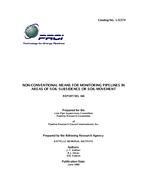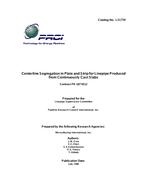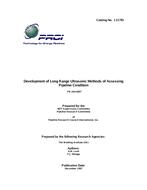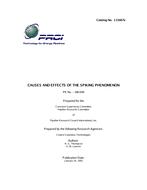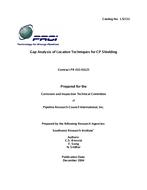Provide PDF Format
PRCI Report 166
- Non-Conventional Means for Monitoring Pipelines in Areas of Soil Subsidence or Soil Movement
- Report / Survey by Pipeline Research Council International, 06/01/1988
- Publisher: PRCI
$125.00$249.00
L51574e
Battelle Memorial Institute
Examines non-conventional techniques for monitoring curvatures, displacement, or strains in buried pipelines. Internal devices, external devices, and fiber optic techniques were examined. Feasibility of each system is discussed and the most promising are identified. Two companion studies 'Guidelines Pipeline Strain Monitoring by Conventional Means' (Reference 1) and 'A Proposed Model for the Intervention Decision Making Process in Pipeline Movement Situations' (Reference 2) have already been completed, and an effort to determine appropriate failure criteria for pipelines in areas of soil instability is currently underway. The objective of this study is to describe methods of pipeline monitoring which are, for the most part, still in the conceptual and/or development phases. It is very likely that the techniques described herein will require extensive validation efforts and significant financial support before they will become reliable tools for routine use Improved pipeline strain monitoring techniques are needed because the conventional techniques (strain gages, inclinometers, and topographical surveying) meet all of the industry's needs. The conventional techniques are expensive, labor intensive, and require access to the pipeline for installation . As such they are limited in use to localized trouble spots that are known to be a problem. None of these techniques could be practically applied to a whole pipeline for any-time monitoring. Techniques that will better satisfy the industry's needs must be adequately sensitive, applicable to the whole pipeline, available at all times (or at least at reasonably frequent intervals), and capable of use without the need to excavate the pipeline or to interfere with its operation.Several non-conventional techniques for monitoring curvatures, displacements, or strains in buried pipelines that may meet these requirements are discussed herein. These fall into three generic classes: internal devices (instrumented pigs), external devices (involving moving a detecting device over the pipeline right-of-way), fiber-optic cables attached to the pipeline over its entire length.
Battelle Memorial Institute
Examines non-conventional techniques for monitoring curvatures, displacement, or strains in buried pipelines. Internal devices, external devices, and fiber optic techniques were examined. Feasibility of each system is discussed and the most promising are identified. Two companion studies 'Guidelines Pipeline Strain Monitoring by Conventional Means' (Reference 1) and 'A Proposed Model for the Intervention Decision Making Process in Pipeline Movement Situations' (Reference 2) have already been completed, and an effort to determine appropriate failure criteria for pipelines in areas of soil instability is currently underway. The objective of this study is to describe methods of pipeline monitoring which are, for the most part, still in the conceptual and/or development phases. It is very likely that the techniques described herein will require extensive validation efforts and significant financial support before they will become reliable tools for routine use Improved pipeline strain monitoring techniques are needed because the conventional techniques (strain gages, inclinometers, and topographical surveying) meet all of the industry's needs. The conventional techniques are expensive, labor intensive, and require access to the pipeline for installation . As such they are limited in use to localized trouble spots that are known to be a problem. None of these techniques could be practically applied to a whole pipeline for any-time monitoring. Techniques that will better satisfy the industry's needs must be adequately sensitive, applicable to the whole pipeline, available at all times (or at least at reasonably frequent intervals), and capable of use without the need to excavate the pipeline or to interfere with its operation.Several non-conventional techniques for monitoring curvatures, displacements, or strains in buried pipelines that may meet these requirements are discussed herein. These fall into three generic classes: internal devices (instrumented pigs), external devices (involving moving a detecting device over the pipeline right-of-way), fiber-optic cables attached to the pipeline over its entire length.
Related Products
PRCI PR-187-9212
Centerline Segregation in Plate and Strip for Linepipe Produced from Continuously Cast Slabs..
$198.00 $395.00
PRCI PR-164-9207
Development of Long Range Ultrasonic Methods of Assessing Pipeline Condition (Phase 4)..
$198.00 $395.00

